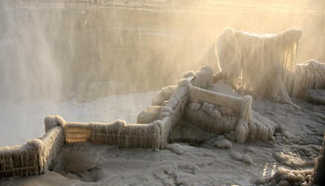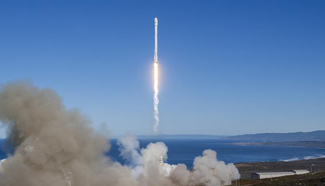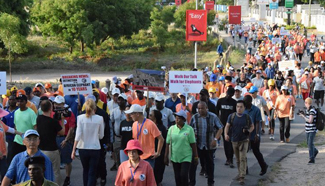SpaceX Falcon 9 lifts off from Space Launch Complex 4E at Vandenberg Air Force Base in California, the U.S., Jan. 14, 2017. (Xinhua)
LOS ANGELES, Jan. 14 (Xinhua) -- SpaceX returns to launching rockets on Saturday, four months after an explosion on the launchpad that caused the company to suspend flights. The U.S. private space firm successfully delivered 10 satellites to low-Earth orbit and landed its Falcon 9 on a drone ship in the Pacific Ocean.
A Falcon 9 lifted off at approximately 9:54 am PST (12:54 p.m. EST) from Space Launch Complex 4E at Vandenberg Air Force Base in California, carrying 10 Iridium-NEXT satellites into low-Earth orbit (LEO).
About two and a half minutes into flight, the first and second stages separate, and the second stage engine ignites to carry the 10 Iridium satellites to their destination.
Approximately 8 minutes after the initial lift-off, the first stage of Falcon 9 then landed on the drone ship "Just Read the Instructions," marking the first time the private company has landed a booster in the Pacific Ocean.
Cheers and applause took over the SpaceX control room, which was streamed live online. "Here we have the first ever successful landing on the 'Just Read the Instructions,' a West Coast drone ship," SpaceX's engineers said.
The feat brings the total number of recovered SpaceX rockets to seven, which were part of the company's effort to produce a fully and rapidly reusable rocket. The company believed it will dramatically reduce the cost of space transport.
"Congratulations @SpaceX on successful first stage landing," the official Iridium Twitter account tweeted just moments after the landing.
The satellites began deployment about an hour after launch. "successful deployment of 10 Iridium-NEXT satellites has been confirmed," SpaceX then tweeted.
The 10 satellites are the first of at least 70 satellites that SpaceX will be launching for Iridium's next generation global satellite constellation, Iridium NEXT.
According to Iridium, it is on track to fully replace the world's largest commercial satellite network of low-earth orbit satellites in what will be one of the largest "tech upgrades" in history.
The satellite communications company has partnered with Thales Alenia Space for the manufacturing, assembly and testing of 81 Iridium NEXT satellites. The process of replacing the satellites one-by-one in a constellation of this size and scale has never been completed before.
The next generation global satellite constellation will deploy a cross-linked Low-Earth Orbit (LEO) architecture, providing coverage over 100 percent of the earth's surface, including across oceans, airways and polar regions.
SpaceX had been grounded until Saturday since a launchpad explosion during preflight fueling on September 1, 2016 that destroyed a Falcon 9 and its payload, the 200 million U.S. dollars Amos-6 communications satellite.
A successful mission is critically important to the California-based company, which is founded in 2002 by billionaire Musk, has been the face of American commercial space industry.












